Click here to print
Ruby Bridges, 6, Symbol of Desegregation
posted June 3, 2016
Thanks to a grant from the National Film Preservation Foundation, Amistad Research Center will restore and make accessible rare footage of a little girl who in 1960 was at the forefront of school desegregation in New Orleans.
n
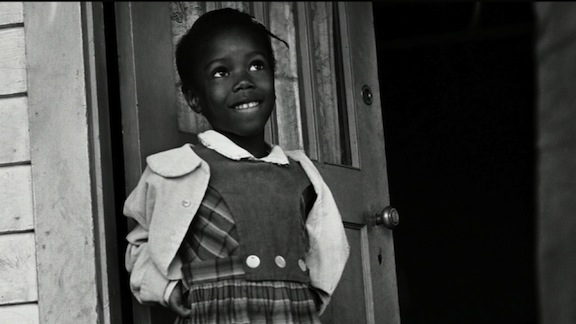
One of the images that the 2013 PBS television series “The African Americans: Many Rivers to Cross” chose to express Ruby Bridges’ captivating personality on the day she enrolled at an until-then segregated, all-white school.
On 14 November 1960, when six-year-old Ruby Bridges turned up at William Frantz Elementary School in New Orleans, hers was no ordinary induction into civic life.
She was a black girl entering a white school in a racially segregated school system, one that typified the American South at the time. Even though in 1954 the U.S. Supreme Court had ruled in Brown v. Board of Education that segregation in public schools — the doctrine of “separate but equal” that maintained highly unequal schooling — was unconstitutional, authorities in Louisiana bluntly refused to change.
In 1960 a federal court demanded compliance, and federal authorities undertook to enforce it. In Louisiana, state officials’ response was to set a skills-and-aptitudes entrance test that they hoped would continue to keep black students out of whites-only schools.
Ruby Bridges’ parents, Lucille and Abon Bridges, sharecroppers with limited formal education, had moved their family to the city in search of better opportunities for Ruby and her three younger siblings. Officials from the National Association for the Advancement of Colored People encouraged the Bridges and other African American parents to have their children sit the rigged entrance tests; Ruby Bridges, who was enrolled at a school that state authorities had designated for black students, only, was one of six African American students who passed that first obstacle.
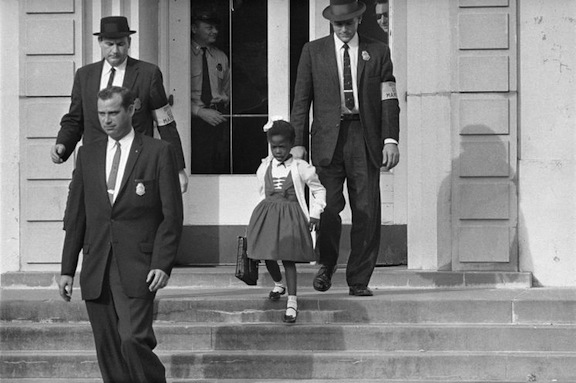
An Associated Press photo showed how fraught the situation was when Ruby Bridges enrolled at her new elementary school. Protecting her were federal Marshals.
n
Three of the students were assigned to Frantz Elementary, but two dropped out, so Ruby Bridges went there alone. (Three others — Leona Tate, Tessie Prevost, and Gail Etienne — went to McDonogh No. 19 school; for their role in integration became known as the McDonogh Three.)
Arriving for the first day of class at William Frantz Elementary, Ruby Bridges and her mother, escorted by U.S. Marshals, were harangued by a mob of irate protesters. At first, Bridges later recalled, she didn’t realize what the gathered crowd were up to. She said on the 2013 public-television program, “Many Rivers to Cross”: “I saw barricades and police officers and just people everywhere. And when I saw all of that, I immediately thought that it was Mardi Gras. I had no idea that they were here to keep me out of the school.”
That day, none of the previously enrolled students, all white, turned up. Their parents boycotted the school altogether for two weeks; only seven of the students turned up when the school reopened. By that time, white parents had moved the other children to schools in an adjoining county. For most of that first year, Ruby Bridges was alone in the classroom with her teacher, Barbara Henry.
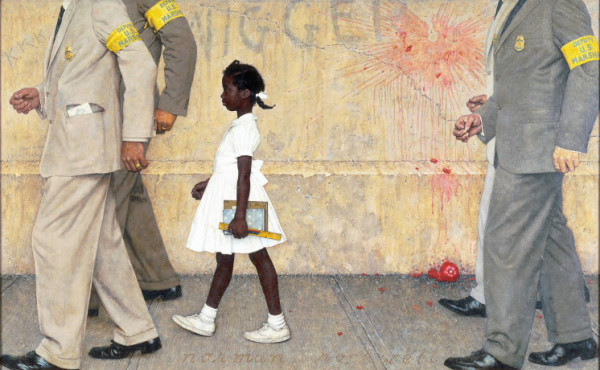
n
Norman Rockwell captured the occasion of Ruby Bridges’ first day at William Frantz Elementary in his later-famous painting “The Problem We All Must Live With” (above). He became aware of the events from Massachusetts, where he had been creating idealized scenes of rural life for the cover of the conservative Saturday Evening Post. In 1963 he left to join Look, which didn’t depict African American subjects only as servants nd the like; his startling image of Ruby Bridges — using a young girl from his own neighborhood as his model — was his first illustration for Look; it appeared as the centerfold of the magazine’s issue of 14 January 1964. In 2011, Ruby Bridges — as the married Ruby Bridges Hall — helped to arrange to have the painting moved on loan from the Normal Rockwell Museum in Stockbridge, Massachusetts, to the White House, where President Barack Obama installed it just outside the Oval Office.
But Rockwell’s image, while a widely known commemoration of Ruby Bridges’ role in school desegregation, is not the only visual record. In early 1961, a few months after that momentous first day, Josie Ritter, a teacher at Frantz Elementary, shot some film footage of Ruby at the school, some in black and white, some in color. It shows her playing there with other children.
Now, Amistad Research Center, at Tulane University, is about to repair and restore the rare, brief footage, thanks to a grant from the National Film Preservation Foundation. The grant will help Amistad to create a new preservation master of the film, as well as a much-needed access copy that Amistad can make available to researchers for viewing. The NFPF recently announced the recipients of its 2016 round of preservation grants: to 39 institutions, to restore and make publicly accessible 64 films. In 1996, the U.S. Congress created the NFPF, which is located in San Francisco, to help save America’s film heritage. It receives federal money through the U.S. Library of Congress that it distributes as grants. It has to date provided preservation support to 284 institutions and saved almost 2,300 films. A catalog of the films is online.
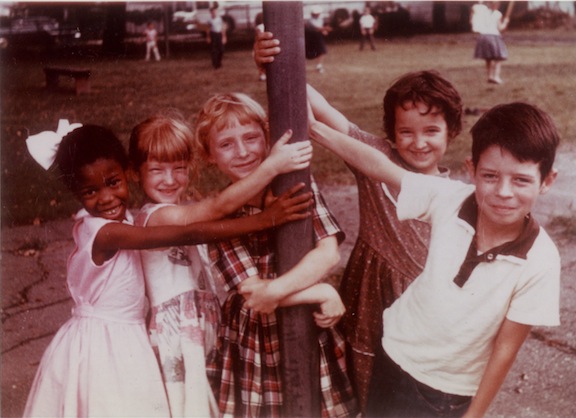
Ruby Bridges, with new friends, a few months into her attendance at the WIlliam Frantz Elementary School in New Orleans. (This image, and the one below, from the Alan Wieder collection at the Amistad Research Center, may not be reproduced without permission from the Amistad Research Center.)
m
Josie Ritter, the teacher, gave her film to Alan Wieder, a now-retired academic at the University of South Carolina who taught about social foundations of education and antiracist education, and who has completed numerous studies on race and education in the United States and South Africa. And in 2010, Wieder donated the Ruby Bridges film to Amistad, along with photographs of her from the same time period, possibly taken the same day as the film. The children shown in the film with Bridges have been tentatively identified as members of the Conner and Chandler families.
Wieder had donated other material to Amistad in 2008, including the correspondence and office records of John A. Stewart, the principal of McDonogh 19 Elementary School where the other three children to pass the entrance test had been placed. The donation also included two notebooks by Betty Wisdom, a New Orleans civil rights advocate and philanthropist, with her reflections on the desegregation of the schools.
The film is in the 8mm format, and its black-and-white and color frames run to a mere 50 feet in length. So the material, which exhibits scratches and other some signs of wear, “is very brief, but is nonetheless a valuable document chronicling an important era in American history,” says Brenda Flora, an archivist at the Amistad Research Center. The footage begins with scenes in black and white of picketers outside the school; it ends with scenes in color of children playing and sitting outside the school.
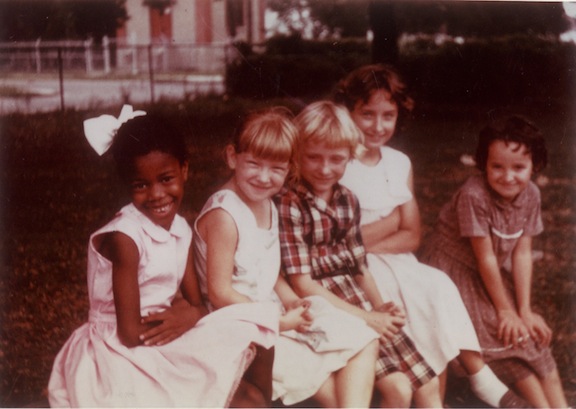
Ruby Bridges, with new friends, a few months into her attendance at the WIlliam Frantz Elementary School in New Orleans. (This image, and the one above, from the Alan Wieder collection at the Amistad Research Center, may not be reproduced without permission from the Amistad Research Center.)
n
In her memoir, Through My Eyes (she has also published two books for children, Ruby Bridges Goes to School: My True Story and Let’s Read About Ruby Bridges), Ruby Bridges related that in her second year at William Frantz Elementary, enough of the heat had gone out of protests that white and African American students attended, together. She completed her elementary education there, then went to an integrated high school before enrolling at a business school in Kansas City and going on to work as a travel agent.
She remained in New Orleans, raising her own four sons along with the children of a brother who had been shot and killed in the city, just as one of her own sons would die.
Some of the children she raised attended William Frantz Elementary School.
Printed from Moving Image Archive News: http://www.movingimagearchivenews.org
URL to article: http://www.movingimagearchivenews.org/ruby-bridges-6-symbol-of-desegregation/
Click here to print